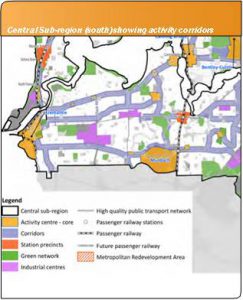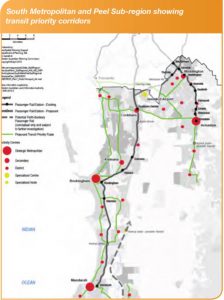Project Sheet Download
Project Objective
“To introduce light rail as a sustainable and value add mass transit transport network encouraging development intensity and connecting activity centres in the South West Metropolitan Region of Perth.”
Recommended Action
The State Government and Opposition support the South West Group’s research and business case development for the introduction of light rail in the South West Metropolitan Region.
Project Objective
“To introduce light rail as a sustainable and value add mass transit transport network encouraging development intensity and connecting activity centres in the South West Metropolitan Region of Perth.”
Introduction
 Light rail is a well-known and popular technology for mass transit that has the potential to facilitate higher density urban development and mixed use through the establishment of transit orientated development corridors and nodes along a fixed alignment.
Light rail is a well-known and popular technology for mass transit that has the potential to facilitate higher density urban development and mixed use through the establishment of transit orientated development corridors and nodes along a fixed alignment.
Melbourne has a well-developed light rail network based on historic tram lines, with Adelaide also servicing its city centre and inner city locations with light rail. The Gold Coast Light Rail (G-Link) is an example of a recently introduced and highly successful light rail project in Queensland, with proposals in Sydney, Canberra and Perth in their planning or development phase and attracting attention.
A number of studies and plans supporting light rail in the South West Metropolitan Region have been prepared and are backed by strategic land use planning frameworks prepared by the State Government identifying activity corridors and transit priority routes.
The State Government’s draft Perth Transport Plan for 3.5 Million and Beyond introduced the Perth Light Rail proposal linking Perth CBD with the University of WA (UWA) and Queen Elizabeth II Medical Centre (QEII) in the west and Curtin University and Canning Bridge to the south east.
The Federal Government has identified value capture, as a key component for funding public transport infrastructure projects such as light rail, and forms the centrepiece for the recently released Smart Cities Plan.
 The South West Group is undertaking its own research for the introduction of light rail to connect activity and employment centres in the region, particularly through congested east- west routes that are poorly serviced by public transport and require an alternative approach to unlocking economic development potential and productivity gains.
The South West Group is undertaking its own research for the introduction of light rail to connect activity and employment centres in the region, particularly through congested east- west routes that are poorly serviced by public transport and require an alternative approach to unlocking economic development potential and productivity gains.
Key Issues & Solutions
The high levels of debt and constrained financial environment at Federal and State levels has reduced the availability and likelihood of government funded public transport infrastructure projects such as light rail.
An alternative funding model for the introduction of light rail is needed, with greater private sector funding required to facilitate development investment and reduce contributions from State and Federal Governments.
The South West Group is undertaking research aimed at identifying and prioritising light rail sections in the region that can be developed in the short term through shared funding models involving value capture, uplifts in zoning, increased densities and private sector investment.
This research is based on a land use and planning led approach, rather than the traditional public transport patronage demand models used by government agencies as the key decision making tool for public transport infrastructure and services provision.
The light rail networks will connect activity centres along activity corridors and be supported with planning scheme amendments that encourage higher residential density and commercial infill developments.
The South West Group will develop business case and cost benefit analysis for priority light rail network sections, in partnership with the member Councils, other key stakeholders and the private sector.
South West Group Position
The South West Group supports the introduction of light rail the South West Metropolitan Region and is undertaking research aimed at identifying priority light rail network sections linking activity centres and realising land use led investment in corridor development.
Recommended Action
The State Government and Opposition support the South West Group’s research and business case development for the introduction of light rail in the South West Metropolitan Region.



